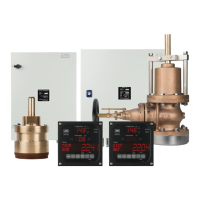10-6
3 Principle of Operation
3.1 Acoustic transmission/reception
3.1.1 Transmitter
The transducer will send two parallel sine waves into the water. During normal operation the
forward crystal (TRU cables 1 and 2) will alter between frequencies 3.800 MHz, 3.875 MHz
and 3.950 MHz while the astern crystal (TRU cables 4 and 5) will alter between frequencies
4.050 MHz, 4.125 MHz and 4.200 MHz. See Figure 1.
Transmitting amplitude is approximately 40 Vpp into 120 ohms (R1a) resp. 70 ohms (T-series),
giving an electrical output of approx. 1.7 W (R1a) resp. 3 W (T-series).
Figure 1 Transmit pulses
The operating frequency, centred on 4 MHz, has been empirically optimised. It is a trade-off
between signal decay, lobe function and transducer design.
3.1.2 Receiver
The signals from the transducer move out into the water. A small amount of the signals are
reflected by objects in the water and move back to the transducer. The time delay for the signal
echo is proportional to the speed of sound in water multiplied with two times the distance to the
object. Depending on receiver duration (i.e. how long the receiver is active) a correspondingly
sized volume is selected, which may give echo at a given echo delay time. Figure 2 shows the
water volume which may give an echo for one specific receiver duration. The WATER
TRACK U log takes nine samples within each echo volume and stores for later correlation.
S2 S1
Hull
40Vpp
4125±75kHz
Transducer
40Vpp
3875±75kHz

